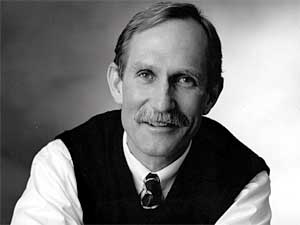|
Audio
Photos
Resources
Your Voice
|
Minnesota native wins Nobel Prize for chemistry
October 8, 2003
 |
| Peter Agre, a Minnesota native and Augsburg College graduate, won the Nobel Prize in chemistry Wednesday. (Photo courtesy of Johns Hopkins School of Medicine) |
Stockholm, Sweden — Minnesota-born Peter Agre and another American, Roderick MacKinnon, won the Nobel Prize in chemistry on Wednesday for studies of tiny transportation tunnels in cell walls, work that illuminates diseases of the heart, kidneys and nervous system.
Agre, 54, of the Johns Hopkins University School of Medicine in Baltimore, discovered in 1988 the "channels" that let water pass in and out of cells, the Royal Swedish Academy said.
Peter Agre's mother, Ellen, lives in Little Canada, a St. Paul suburb. She says her husband Courtland was on his deathbed in October, 1995, when he predicted that Peter would win a Nobel Prize. Ellen Agre says Peter, one of six children, was studious, meticulous and an avid reader.
"As a little boy he was a very quiet, reclusive kind of a kid. When the little model airplanes and things came out, he was notorious for wanting to put those together," says Ellen Agre. "He had bunches of them. He'd never let his father help him, because when his dad helped him the wheels wouldn't go around or the propellers wouldn't go around -- whereas when Peter did them they worked perfectly, as if they were real."
The Agres moved from Northfield to Minneapolis where Courtland Agre, a chemistry professor, took a job at Augsburg College. Peter was a senior at Roosevelt High School at the time, and his mother remembers he was bored with classes.
|
I'm jubilant. I'm overwhelmed, frankly. One doesn't plan to have this sort of thing happen.... Deep down in your heart a scientist will always dream about something like this.
- Peter Agre, Nobel Prize winner |
"My husband asked him if he'd like to start college, now, his senior year. And he said, 'Oh, you mean I can?' And so he said, 'Well, I'll look into it," she says.
Peter took just two and a half years to graduate from Augsburg, in 1970. One of his teachers, chemistry professor Arlin Gyberg, remembers Agre was a model student -- who opposed the Vietnam War.
"His father was rather conservative politically, and the Vietnam War was raging. Peter was pretty much anti-Vietnam War, and after graduation he went over to Vietnam to see what was going on," recalls Gyberg. "He came back and talked to Court and changed Court's mind about a lot of his views."
Agre earned his medical degree from Johns Hopkins medical school, and joined the faculty there in 1984. Ellen Agre remembers Peter's decision to become a scientist.
"At the time he said he was not a bedside doctor, and that's whey he chose to go into medical research," she says.
Agre says she and her late husband came from a farm and small town background in South Dakota. Both families, she says, valued education, sending many of their children to college.
"We've all been from humble beginnings, and we're just so grateful for the gifts we've been given -- of intelligence and the ability to help others," she says.
Roderick MacKinnon, 47, did key studies of the structure and workings of channels that transport charged particles called ions through cell walls. He is with the Howard Hughes Medical Institute at The Rockefeller University in New York.
Ion and water channels are key to such crucial activities as making the heart beat, the brain function and the limbs move. When channels malfunction, the result can cause such conditions as cystic fibrosis, irregular heartbeat, high blood pressure, some forms of paralysis and a disease called diabetes insipidus, which is marked by extreme thirst and heavy urination. Not surprisingly, ion channels are important drug targets for the pharmaceutical industry.
Because of Agre's work, researchers can follow in detail a water molecule on its way through the cell wall and understand why only water, not other small molecules or ions, can pass, the academy said.
Agre said, "I'm jubilant. I'm overwhelmed, frankly. One doesn't plan to have this sort of thing happen.... Deep down in your heart a scientist will always dream about something like this."
The pair will share a check for $1.3 million.
The only Nobel awarded for work done in Minnesota went to Drs. Philip Hench and Edward Kendall. The two won the prize for Physiology or Medicine in 1950 for finding that cortisone could treat rheumatoid arthritis. Cortisone and its variants became the treatment for dozens of diseases.
Other winners with Minnesota roots include author Sinclair Lewis, who won the award for literature in 1930, and Frank B. Kellogg, the U.S. Secretary of State who won the Nobel Peace Prize in 1929 for creating the Kellogg-Briand Peace Act, under which 62 nations renounced war.
(The Associated Press contributed to this report)
|
News Headlines
|
Related Subjects
|
